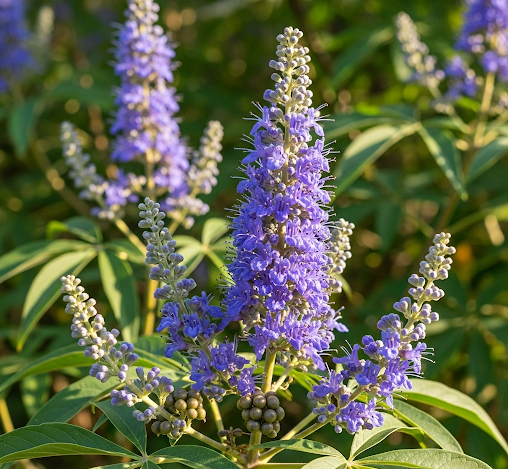Chaste Tree Seeds
Chaste Tree Seeds
Couldn't load pickup availability
Chaste Tree
(Vitex angus castus)
Vitex agnus-castus, commonly known as chaste tree, monk’s pepper, or chasteberry, is a deciduous shrub or small tree native to the Mediterranean region and western Asia. It is valued both as an ornamental plant and for its traditional medicinal uses. The plant can grow between 9 to 18 feet tall, developing a multi-stemmed form with an open, spreading habit. Its aromatic, palmate leaves resemble those of cannabis in shape, though they are typically gray-green in color. During summer, it produces long, showy spikes of small lavender to violet flowers that are highly attractive to bees, butterflies, and other pollinators. These flowers give way to small, peppercorn-like berries that have a spicy, pungent aroma.
Vitex agnus-castus thrives in warm, sunny locations with well-drained soil and can tolerate drought once established. It is commonly planted in gardens and landscapes for its ornamental beauty, especially in regions with mild winters. The plant has been cultivated for centuries not only for its aesthetics but also for its herbal properties. The dried berries have a long history of use in traditional medicine, particularly for supporting women’s reproductive health. In historical Europe, monks reportedly used the berries to suppress libido, hence the name “monk’s pepper.” Modern herbalists still use extracts of the plant for various hormone-related applications, though scientific studies continue to examine its effectiveness.
In addition to its cultural and medicinal significance, Vitex agnus-castus is valued for its resilience and low maintenance. It is resistant to most pests and diseases, making it a reliable choice for gardeners seeking a hardy, attractive plant. Its ability to draw in beneficial pollinators adds ecological value, making it a functional as well as decorative addition to landscapes. With proper pruning, the chaste tree can be shaped into a dense shrub or a small, graceful tree, offering versatility in garden design.
Zones: 7 to 9
Germination Range: 50-70%
Stratification Requirement: None required
Planting Instructions:
Because the seed coat is hard, lightly scarify them by rubbing with fine sandpaper or nicking with a knife. This helps water penetrate and speeds germination. Soak the seeds in warm water for 12–24 hours afterward.
Fill small pots or a seed tray with a well-draining medium, such as a mix of potting soil and coarse sand or perlite. Sow the seeds about ¼ inch (6 mm) deep, then lightly cover with soil. Water gently to keep the soil evenly moist but never soggy. Place the pots in a warm, sunny location with temperatures around 70–75°F (21–24°C).
Germination can be slow, taking anywhere from 3 to 6 weeks, sometimes longer. Once the seedlings are large enough to handle, transplant them into individual pots and continue growing until they are sturdy enough to plant outdoors. When transplanting outside, choose a sunny spot with well-drained soil, spacing them at least 5–10 feet apart depending on desired size.
Share


